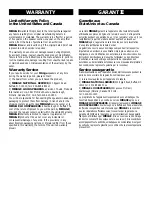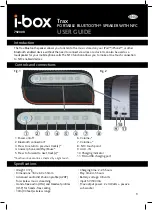
o w n e r s m a n u a l
o m n i p o l a r - S e r i e s
INTRODUCTION
Congratulations on your purchase of Mirage
®
loudspeakers! Proprietary
Mirage
®
technology and high quality manufacturing will allow you to
enjoy the most natural and accurate music reproduction, a trademark of
all Mirage
®
speakers, for many years.
The advice offered in this manual is aimed at helping you maximize and
maintain peak performance, and therefore, your listening satisfaction.
Please take the time to read all of the instructions contained in this
manual to make certain your system is properly installed and
functioning correctly.
Break-In Period
We strongly advise that you resist the temptation to play the OM series
to their full capabilities or experiment with critical placement and
listening until they have been properly broken in. This process should
last approximately 50 to 100 hours of music playback.This can be
done efficiently and effectively by putting your compact disc player on
Repeat mode, while playing a CD with a wide dynamic range at normal
listening levels.
Speaker placement
For best stereo imaging, the left and right speakers should be the same
distance from their respective side walls. If the distance from one
speaker to the listener is very different from the other it can affect the
soundstage or stereo imaging. Therefore, the ideal position is having the
speakers equidistant to the listener.
A general guideline for speaker placement is to set up the space
between speaker and listener at approximately 1 1/2 times the
distance between the speakers. For example, if the speakers are
ideally placed a minimum of 6-feet (1.8m) apart, the best seating
position would be 9-feet (2.4m) away. (See Figiure3)
The next is referred to as the rule of thirds. This formula dictates that
the room should be divided into thirds, with the speakers placed a third
of the way into the room. The listener is positioned in the second third
of the room, with the last third of the room behind the listener.This
may be impractical or difficult to integrate into some decors, so try to
at least respect an adequate distance from side and rear walls. The OM
Series are not finicky models and can perform quite well with even the
least desired placement, but we suggest respecting a distance of two to
three feet from the rear wall, a minimum of at least 1-foot.This will
allow the OM Series to create incredible depth to the soundstage.
Placing them closer than a foot to the wall is fine and will allow very
nice stereo imaging, but a little less depth to the soundstage. Do not
make the side and rear wall distances equidistant from the speaker, as it
will negatively affect room reflections.
The rule of thirds can be difficult to apply to most room environments.
Mirage Omnipolar are not difficult to place in a room, just respect the
guideline of listening position being approximately 1.5 times the distance
between the speakers and provide from 1 to 3 feet clearance from the
rear wall.
Once the speaker position has been selected, choose a familiar
recording to determine whether the speaker's positioning provides the
best musical quality, imaging, and tonal balance.
Connections
The Mirage Omnipolar Series has been fitted with two pairs of high
quality, 5-way, gold plated binding posts The five way binding posts
accept most popular methods of speaker wire connection, though we
recommend the more secure fit of spade lugs and locking banana plugs.
Bare wire is not recommended as exposed wire ends can corrode and
degrade the signal.
One set of standard speaker cable can be used if you plan on a
conventional connection. Connect the speaker cable from the positive
(+) terminal on the amp to the positive (+) terminal on the speaker.
Connect the negative (-) terminal on the amplifier to the negative (-)
terminal on the speaker. This method can be applied to the bi-wireable
OM series speakers as long as the shorting straps are in place on
the terminals. (See Figure 1)
The OM Series is equipped with two pairs of binding posts to permit
bi-wiring. When engineers design a crossover, they're assuming that the
terminals of the speaker see the zero source impedance of an amplifier
driving it. In reality, you have a cable that's connected from the speaker
terminals to the low source impedance of an amplifier, making the cable
common to the low and high frequency crossover. Bi-wiring eliminates
the common impedance and as a result cleans up the transition area
between low and high frequencies. The terminations on the wire should
be a high grade as well, and we recommend the use of high quality
spades that provide a tight connection to the speaker terminals.
Start this process by removing the shorting straps.The tweeter's
terminals are on top, the woofer's on the bottom. If you are using two
lengths of wire instead of a pre-made bi-wireable cable, twist the
positive leads of the two wires together so they can both be inserted
into the positive terminal on the amplifier. Follow the same procedure
for the negative leads. Then connect the two positive leads to the
positive terminals in back of the speaker, and the negative leads to the
negative terminals. (See Figure 2)
Be sure to turn off your amplifier when connecting speakers to your
amplifier. Not doing so could result could result in shorting from the
speaker's leads and potential damage to the amplifier.
POWERED MODELS
Except for the OM-7, all the models in the OM series are of a
Powered/Passive design. Stereophile magazine called this concept "an
idea whose time should long have since come", in reference to the first
powered Omnipolar speaker, the OM-6. Low bass frequencies can be
generated by either a very large interior volume of the cabinet, which in
turn translates to a big speaker that is difficult to integrate into the
room décor, or by sufficiently powering the bass drivers.
Built-In Amplification
A dedicated high-powered amplifier is integrated into each cabinet to
drive the low frequencies while midrange and high frequencies are
powered by the connected components. The built-in amplifiers relieve
the burden of amp-draining low frequencies, allowing the speakers to be
efficiently driven by most amplifiers.
The OM series incorporates a MOSFET ( Metal Oxide Semiconductor
Field Effect Transistor) power amplifier technology called Pulse Width
Modulation(PWM). The amplifier uses circuitry that responds to
incipient clipping by reducing the input level and releasing it as
conditions return to normal. The 250-watt PWM amplifier used in the
OM-5 provides 90% efficiency as compared to approximately 20%
efficiency in conventional amplifiers and thus generates significantly
less heat.
Volume and frequency controls permit fine-tuning of the bass
frequencies to suit personal tastes and guarantee maximum
performance in any listening environment.
This method permits the best of both worlds, an aesthetically pleasing
cabinet that doesn't require much floor space yet is capable of
delivering the deepest bass frequencies.
3







































